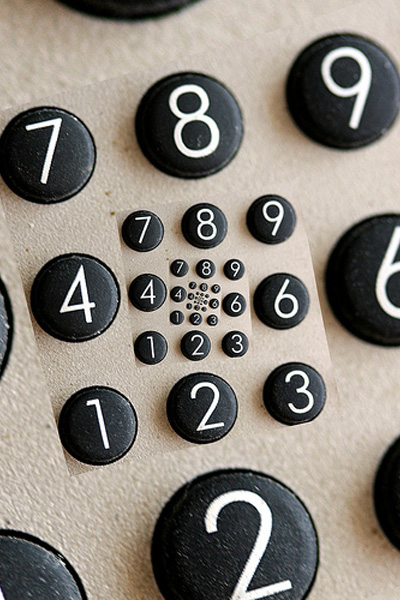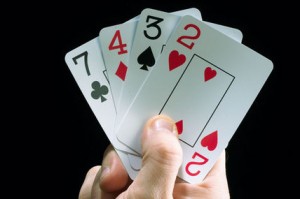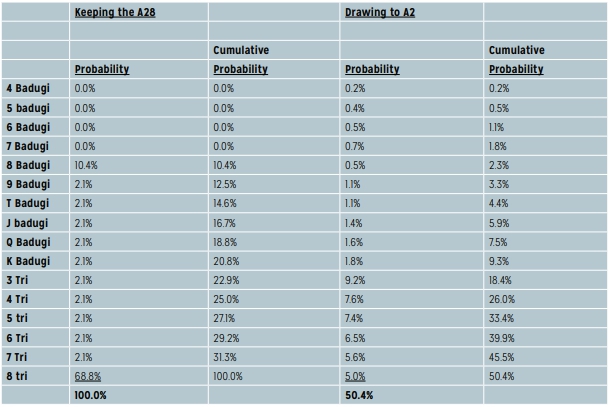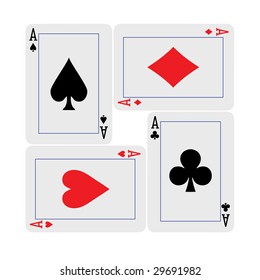Badugi
Badugi Poker Game Description
In Badugi poker, the goal is to hold the lowest possible hand at the showdown. Aces are considered the lowest card. When cards within the same hand are paired or of the same suit, the highest card is discounted in the evaluation of the hand. The hand is then evaluated based upon the remaining number of cards.
A 'Badugi' is defined as holding four cards that are not suited nor paired. The best possible Badugi hand would be A234; all unsuited. The worst hand still meeting the definition of a Badugi would be K,Q,J,10; all unsuited. Any hand defined as a Badugi is superior to any hand containing suited cards or pairs.
HOW TO PLAY BADUGI. Badugi is similar to traditional poker games except that it uses 4 cards and ranks hands differently. In order to win a hand in Badugi, players want a hand with the lowest rank cards that. Badugi is a poker-like game played with four-card hands. To win the pot at the showdown you need to have the lowest set of cards with no two cards of the same rank or suit, ace ranking low. The best possible hand is therefore A-2-3-4 with one card of each suit. Badugi Poker is possibly the most unique form of poker to ever reach mainstream success. This poker game remains very popular in South Eastern Asia, particularly South Korea, where the game was.
If a final hand contains a pair, only one card of the pair can be used in determining the winner. The paired card deemed least advantageous to the player is discounted and the hand is evaluated as a three-card hand. If the hand contains two pairs or trips, two cards would be discounted and the hand is evaluated as a two-card hand. If the hand contains four-of-a-kind, three cards would be discounted and the player would hold the worst possible variant; a one-card hand.
In a similar fashion, if a final hand contains two suited cards, the lowest card is retained and the highest card is discounted resulting in a three-card hand. If three cards were suited, the highest two cards would be discounted resulting in a two-card hand. In an extreme case with all cards suited in the final hand, the player would hold the worst possible variant; a one-card hand.
Hands containing both suited and paired cards are extremely weak as both the above rule-sets for discounting cards come into play limiting the number of cards that will be evaluated on the showdown.
A Badugi is a superior hand to any three-card, two-card or one-card hands. In similar fashion, any three-card hand is superior to any two or one-card hand and so on. If both players have a similar number of cards evaluated at the showdown, the hands are compared by evaluating each of the hands from the highest to lowest cards.
By way of examples:
Example 1
Player 1 has 8, 4, 3, A
Player 2 has 8, 5, 2, A
Both players have a 'Badugi' (four-card hand) since they both have four cards that are unsuited and non-paired. On evaluation from highest to lowest card, both hands contain an eight however Player 1 holds the best hand when comparing the 5 versus the 4 on the next highest card.
Example 2
Player 1 has 10, 9, 9, 4
Player 2 has K, 7, 6, 2
Both players have three-card hands. Player 1 would have a three-card hand consisting of 10, 9, 4 with the 9 having been discounted since is it paired with the 9 and is higher in value to the same suited 4. Player 2 would have a three-card hand consisting of 7, 6, 2 as the K would be discounted as the higher same suited card. Evaluating from highest to lowest of the two three-card hands, Player 2 holds the better hand.
Example 3
Player 1 has 5, 5, 5, A
Player 2 has 9, 6, 4, 2
Both players have two-card hands. Player 1 would have a two-card hand consisting of any of the five's plus A. Player 2 would have a two-card hand consisting of 4, 2 as the top two highest value hearts would be discounted. Evaluating from highest to lowest of the two two-card hands, Player 2 holds the better hand.
Example 4
Player 1 has 9, 7, 5, 2
Player 2 has 6, 4, 4, A
Player 1 has a three-card hand consisting of 9, 5, , 2 that would automatically beat Player 2 who holds a two-card hand consisting of 4, A
Click here for a list of the top 25 ranked Badugi hands

Bet Limits
When you first go to a table, an information box appears that tells you the name of the game ('Welcome to Badugi with Blinds'), the limits (for example, '$4/$8 Fixed Limit'), the blinds (for example, 'Blinds: $2/$4'), and the buy-in (for example, 'Minimum Buy-in: $40').
Fixed-Limit Games - The software enforces the bet limits, which are determined by the stakes offered at the particular table. For example, at a $4-$8 table, the limit on any bet is $4 on the first two betting rounds and $8 on the final two betting rounds. There is a bet and three raises allowed in each individual round. Each bet or raise is at the limit for that round. Thus, the first player to bet in the first round of betting has the choice of folding or betting $4. If someone has made a bet, the next player has the choice of folding, calling the $4, or raising $4 (making the total bet at that point $8). If there has been a raise, the next player has the choice of folding, calling the $8, or raising $4 (making the total bet at that point $12).
Blinds
The blinds are a bet/ante related to the small bet. The Small Blind is one half the small or minimum bet rounded down to the nearest dollar or even denomination while the Big Blind is equal to the small bet. By way of example in a $1-$2 fixed limit game, the big blind is $1 and the small blind is $.50.

Poker Game BettingThe betting starts after four cards are dealt to each of the participating players. At this point, there is a round of betting. After all bets have been equalized, active players exchanges from 0-4 cards from their hands. Players are given the two subsequent opportunities to exchange cards followed by a betting round. The final bet round and showdown occurs after three opportunities to exchange cards should two or more players remain in the pot.
Rake

Our house rake is between 0% and 5% of the pot size.
Posting to Enter a Game
New players can enter a game in the big blind position to avoid paying the new player post, which is equivalent to the big blind. A new player can choose to post the equivalent of the big blind to enter the game at any time except when he is between the button and the big blind position. A returning player who has missed the big blind or small blind can choose to post the missed blinds and reenter the game, as long as he is not between the button and the big blind position. A seated player who has missed the blinds or a player just sitting down can always choose to wait for the blind, that is, sit out until the blind gets to him.
Other Important Points
Buy-In - When you first sit down to the table, you are prompted with 'Enter $ to buy in.' The amount displayed to you is set to default to your entire account balance. If you wish to take a lesser amount to the table, simply override the amount in the box by typing in the desired buy-in amount. The minimum buy-in is generally 10 times the small bet.
Badugi Dealer Our virtual dealer strictly enforces all game rules. The starting dealer position, or dealer button, is chosen at random and moves clockwise one player after each hand. To start a hand, the cards are dealt in a clockwise direction from the dealer button. All new players to the game must either post the equivalent of the big blind or wait for their turn in the big blind. This prevents players from gaining an advantage by avoiding the blinds and jumping in and out of games. Each time the cards are dealt, a new betting round begins. A hand starts when the first card is dealt and ends when a winner is declared.
Dealer Button - The yellow disk (labeled with a D) that moves from player to player at the beginning of each hand is called the dealer button. It identifies the current dealer position-as if that player were actually dealing the cards. The player at this location is said to be on the button. After each completed hand, the dealer button moves one player to the left.
Missed Blinds - Players are required to post the small blind and the big blind once per round or their equivalent upon re-entry to the game if the blinds are missed. The software will prompt you if you have missed one or both blinds to put in the correct amount. You can also wait for the blind to get to your position. This is called coming in on the blind. (The term also applies to when you first sit down.) (Also see 'Posting to Enter a Game' above.)
Raise/Call/Check/Fold - Once a betting round has started you must select one of these options from the popup box that appears when it is your turn. If you choose one of the automatic options, your bet is made automatically on your turn. If you select Sit Out or you close the window after a round has started, your bet will be considered a fold. If your connection is lost, your hand will be played as an all-in bet. (This feature is restricted to a maximum number of times per day, to prevent individuals from gaining an advantage by purposely allowing themselves to be timed out.)
Option - The player who has the big blind is given the option to raise, check, call, or fold when it is his turn. If no one has raised, the big blind has the option of checking (that is, not increasing the bet) or raising (the prompt says Bet).
Discard - After the first round of betting, active players are offered the opportunity to draw to their hands. That is, they can discard to change or improve their four-card hands by replacing none, some, or all of their cards. You are prompted in turn to indicate which cards to keep and which to discard. Click each card you wish to hold (keep). The prompt changes to reflect what your action means. For example, if you click on two cards that you wish to keep, the prompt is Discard 2 Cards on my turn. If that is not what you wish to do, click or unclick cards appropriately until the software shows you discarding as you wish. Each card you click shows a blue H in the lower left corner of the card and the card slides slightly downward. To remove the blue H from a card, click on the card again before the draw and that card will not be discarded. Those cards not marked with a blue H-and remaining above those that are-will be your discards. If you do not click any cards, you are offered these choices: I will play these and Discard All. Again, if that is not what you want, click cards appropriately until the software shows you discarding as you wish. You can speed the game up by clicking the cards you wish to keep before the action gets to you. Clicking the cards does not cause discarding to take place until you react to the Discard prompt.
Insufficient Cards
As there are only 52 cards in the deck, there will be occasions depending upon the number of players active in the hand and the number of cards exchanged where there will be insufficient cards without re-using previously mucked cards. When this occasion arises, the mucked and discarded cards are shuffled and used to complete the hand. Our software is programmed so that, on those occasions when not enough cards remain in the deck to complete the deal, a player will not get his own discards back-but he may receive another player's discards or his own cards from a previous exchange should the muck have been reshuffled in the interim time period.
by Peter GelencserTwo Plus Two Magazine, Vol. 16, No. 12In my previous article, I wrote about peeling against badugis and in today's article I’m going to share some tips for playing rivers.
Example #1
Predraw we pat and opponent(s) are drawing one at the end.
There is a pretty common situation where we stand pat from the beginning of the hand and our opponent draws one on the river. How should we play on the river when we are out of position and how can we exploit our opponent? (We will talk about the latter in Example #3)
Let’s say a player in the cutoff has raised, Button flats, we three-bet from the big blind and both opponents call. The rest of the hand goes like this:
1st draw: Hero pat, Cutoff takes two, Button takes two, Hero bets, and both players call
2nd draw: Hero pat, Cutoff takes two, Button takes one, Hero bets, and only the Button calls
3rd draw: Hero pat and Button takes one
How should we play with certain hands on the river? In this situation, we don’t really have bluffs. It doesn’t make sense for us to bet out of position with marginal hands (like a QT84 badugi) because worse hands are not calling and better hands are not folding. If we bet and our opponent has a hand that is clearly a bluff catcher (for example A23-X or A26K), he can make an exploitive fold.
What happens when we decide to bet? It means we have a hand that is a bit better than a medium strength hand, like a, 8-, 9- or Ten-badugi. These are pretty strong badugis, but even with a hand like 8765 we might not be ahead of our opponent’s continue range. Let’s assume our opponent has A24. If we bet, it doesn’t matter if he would improve to a K42A badugi since he will fold that.
If he makes a badugi that puts further bets into the pot, he is 56% to have a stronger badugi (he makes a better badugi with a 3,5,6,7,8 and a worse one with 9,T,J,Q).
In this situation, I used to play the strategy of checking range when I didn’t have any bluffs and then continue the hand depending on my opponent. If I assume my opponent is never bluffing, I would fold every hand that doesn’t beat even a part of his value range (King-Queen badugi). If I think my opponent is capable of bluffing, I would call with a few bluff catchers (like Queen badugi). If I had a very strong hand (usually need at least a 7 badugi to qualify for that) I could also check-raise for value.
There are a few hands that are not strong enough to check-raise (T-8 badugis) but are too strong to play as bluff catchers. With these hands, it makes sense to make a bet, but it can possibly be exploited by my opponent (I will talk about how a bit later).
Example #2
HU vs. one opponent: Small Blind pat vs. Big Blind who takes one.
The situation is a bit different if we raise from the small blind and the Big Blind calls. In this situation, he can be more inclined to snow predraw with a hand like 973A than in the previous example.
The best predraw snow hands are four low cards of the same suit. A hand like 973A is much better from a blocker perspective than a hand like KJ9A. In this spot (since we have bluffs), it makes sense to make more river value bets and put our opponents bluff catcher hands like A23-X or K62A in a tougher spot.

Example #3
Badugi
We make Q72A badugi vs. predraw pat.

In this hand, the Small Blind raises and we call from the big blind with A2
1st draw: Pat – 2, we improve to A27
2nd draw: Pat – 1, we brick
3rd draw: Pat -1, we make Q72A
Let’s assume our opponent bets but we know he never bluffs in this spot. He is not the type of player to predraw/snow/pat with even a hand like T973 and he never bets a King-Jack badugi. So when he bets, his most likely hand is a medium or strong badugi, like a Ten or better. Against him, making an exploitive fold with our hand (Q72A badugi) is a good decision.
What should we do in the same situation if our opponent checks? In this case, he is always going to have a King-Jack badugi so we have a clear value bet.
Since we know our opponents strategy of always betting medium or stronger badugis, it means that his checking range will consist of King-Queen-Jack badugis. It’s possible that sometimes he will call with a better hand (like JT94, J832, Q652) but if he calls with every badugi, he will still be calling with worse hands more often than better ones.
When someone pats predraw, their average badugi is Q7xx. If our opponent checks his whole range, then we have a quite average hand and should be looking to check back. But once we remove the stronger badugis from his check range, he will be much more likely to have a weaker badugi than one stronger than ours.
The situation is once again different if we assume our opponent will be folding all of his King badugis. In this situation, our hand strength starts nearing average again, because if our opponent only has predraw Jack or Queen badugi, he’s going to have a Jack 42.5% of the time and a Queen 57.5% of the time. Some of the Queen combos beat us, but we are still a bit more likely to get paid off by worse than get called by better.
Example #4
Here’s an example of overplaying a marginal badugi.
The Button opens and Big Blind calls
1st draw: Big Blind takes two to A6 and makes a strong 864A badugi.
Badugi Pokerstars
Button takes three and improves to A26 from Axx
Big Blind bets, Button raises, and Big Blind three-bets
2nd draw: 1 – Pat
Big Blind bets and Button raises.
Here, Big Blind made a mistake and three-bet his hand.
Based on the progress of the hand so far, the ranges look like this:
Big Blind’s range on average will consist of T9xx badugi (when someone takes two and makes a badugi, this will be their average hand strength)
The Button’s range will be a very strong three-card draw (since he took three, then raised and drew one)
In this situation, if the Button raises his average hand strength should be stronger than T9xx. Most players only raise here with a 9 badugi or better. But let’s assume that our opponent has A24 and raises us with every Ten or better badugi. In this scenario, we will still be underdogs overall (we lose against 3,5,6,7,8 and win against a T or 9, so we are going to have the worse hand 71% of the time (5:2 ratio between hands we lose and win against)).
It’s important to note that this is only a mistake (but a pretty significant one) if our opponent is only raising for value. There are aggressive players who overbluff in certain spots either to make us fold (if we have an Q54A badugi for example) or to make us draw (for example we discard the Q from the Q54A badugi, drawing to A45 after which he gets to pat behind and is a big favorite with his K74A badugi).
What kinds of hands we should be three-betting for value on the turn depends on our opponents’ bluffing and semi-bluffing frequencies. In general, this is a spot where opponents are rarely bluffing and our opponents’ average range is a 9- or better badugi. In this spot, three-betting an 8-badugi is clearly an overplay.
Badugi Strategy
In the hand above, I was the Button with 764A and decided to four-bet. In a vacuum, this could be considered a slight overplay, but I knew my opponent and knew that he plays every badugi better than an 8 this way and also plays a few strong 9-badugis this way. Against this range, I considered my 764A badugi to be a favorite and decided to four-bet, and then I bet the river too and took down the pot. In retrospect, I think this was too thin of a value raise. Unfortunately, there are no charts or data that tells us how often a player will have a 9, 8, 7, 6 or better badugi when they pat drawing two.
Considering previous calculations, I’m fairly certain that if my opponent only has 8 or better badugi, then 76xx is very close and best case scenario I’m going to be a 55% favorite, but it’s also possible that I will have only 45%, so an underdog. If I’m a small favorite (51-52%), then raising still carries risk, because despite the fact that I’ll be winning more often than not, my opponent could still have a monster and if he raises once again, I’ll be losing an extra bet, which will not be made up for by the fact that I’m a small favorite against his range.
The examples above show why badugi is such a special and exciting game. It’s a very complex game where based on our opponents’ strategy sometimes we fold a certain hand, while other times we raise it for value in the same spot (Example #3, Q72A). It’s no surprise that this game is very popular and is also a part of most mix game rotations, so learning more about it will be beneficial to every mix game player.
Poker Strategy and Other Topics - December 2020
by Norm Zadeh, Ph.D.
by David Sklansky
by Carlos Welch
by Kevin Haney
by Ben Saxton
by Robert Samuels
by Nick Willett
by Ray Zee